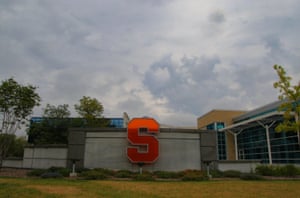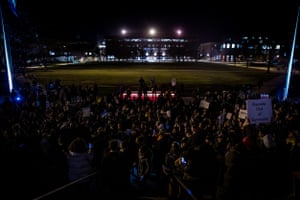It’s a university, it says, for those wanting a “quintessential college experience”, and which touts its “gorgeous campus” and 150 years of history.
But in recent weeks, Syracuse University in upstate New York – a five-hour train north of New York City – has been in national news for far less harmonious reasons: over a dozen hate incidents involving racist and antisemitic slurs have created a climate of fear for students and some faculty.
Nathena Murray, a sophomore, told the Guardian: “Just knowing that there’s people who have such hatred toward people who look like me … I have found myself having to look over my shoulder when I’m walking, be cautious with whom I’m sitting with.”
Student protests against the university’s administration for not taking the incidents seriously and hesitating over broad diversity efforts have culminated in calls for the resignation of the school’s chancellor, Kent Syverud.
Despite an investigation into the incidents by the school – which says it is doing all it can – and Syracuse police, the incidents have continued. The FBI has come in to help investigate.

A campus in crisis
In the early hours of last Tuesday, students reported to campus police that they received a copy of the Christchurch manifesto – the document that was sent out minutes before the deadly mass shooting in New Zealand in March – while in the library via Airdrop. In order to receive an Airdrop, the sender and receiver have to be in close proximity.
As word of the incident spread, students panicked. Various law enforcement agencies, including the FBI, have said the Airdrop element was an unsubstantiated rumor – they have not been able to “locate a single individual who directly received an AirDrop”, though the investigation is still continuing.
Hours before the Airdrop, an anonymous user on GreekRank.com, a forum typically used by fraternities and sororities, posted the manifesto on Syracuse’s GreekRank page. “1488, Brothers and Sisters. Read up” read the post’s title, a number that represents an in-the-know nod to the white supremacist movement.
The incident came as tensions on campus were intensifying. Among the incidents, anti-Asian and anti-black slurs were written inside multiple dorms. A swastika was drawn in a snowbank near campus. An antisemitic death threat was sent to a professor hours after the alleged Airdrop incident.
Syracuse officials say they believe as many as five people could be responsible. An anonymous donor has offered up to $50,000 to anyone who comes forward with information.
So far, students have been punished for one incident: four students and members of a fraternity were suspended after the university found them to be part of a large group of men who yelled the N-word at a black woman walking on a street near campus.
But the perpetrators of all other incidents remain at large. The most recent report from the university’s department of public safety from 21 November – two days before te university closed for Thanksgiving break – said it was investigating four other recent incidents of racist graffiti.

‘It could be somebody that lives on my floor ’
Syracuse University is home to over 22,000 students, all living within a three-mile radius.
Like many smaller cities in upstate New York, Syracuse’s surrounding areas tend to lean conservative, and it’s not uncommon to drive out a few minutes from the city of 140,000 people and see Confederate flag and Maga signs in front yards.
Tahliyah Tabron, a freshman, said that not knowing who was behind the attacks put her on edge. “It could be somebody that walks by me, it could be somebody that’s in my class. It could be somebody that lives on my floor. That’s the kind of thing that did instill some fear in me.”
On a campus where black and Asian students each make up about 6% of the university’s student population and 8% of students are Hispanic, the attacks have felt personal. “Imagine walking into the bathroom and seeing I hate [N-word]. If you’re a black person, change that word to your name because that’s what it’s saying,” said Dumebi Enemor, a freshman.
In October, Enemor said she overheard students watching a college football game on TV shout racist remarks at a black player. “ It’s not just in our heads,” she said.

The attacks have spread to a faculty member, Genevieve García de Müeller, who received an antisemitic death threat to her work email.
García de Müeller, who is Mexican and Jewish, said: “It got me really scared because it felt like they were very specifically trying to tell me that there was some threat to me as a person.”
She added that the university administration was slow to make the incident known, sending out an internal email nearly 48 hours after she received the email and reported it to police. It took the chancellor two days to talk with her after she received the email. By then it was too little, too late.
“My case is representative of how faculty of color are being treated on campus,” García de Müeller said. “They try to pretend these things don’t happen because it’s going to affect the way that people think about the university.”
Protests erupt
The hate speech on Syracuse’s campus coincides with a broader increase in hate crimes in the US. The university insists it is doing everything it can to investigate the incidents and stop them.
But the recent incidents have challenged the leadership of the school’s chancellor, Kent Syverud, who has recently faced criticism for being a champion of free speech. He created a Free Speech Working Group in the spring and told faculty in a meeting in September that “if our students are going to learn or seek knowledge and grow, I think they need to be exposed to a true range of views”.
In response to the string of incidents, Syverud said in a video statement that the recent incidents “are hate speech and not free speech”.
Some students and faculty have echoed García de Müeller concerns and say they have been disappointed and angry with the administration’s handling of the incidents. They say leaders have been slow to act on and condemn them.
Hundreds of students set up camp in the Barnes Center, a sports center, for an eight-day sit-in as part of the #NotAgainSU movement.

Student protests culminated with a heated forum last Wednesday. Organizers gave Syverud until 7pm to sign on to a list of demands that included broad diversity and inclusion efforts. Syverud hesitated to sign a list of demands from #NotAgainSU, saying he could not promise to meet all of them yet.
Chanting “sign or resign”, students marched to his off-campus residence several blocks away from the forum. Syverud signed the demands later that night.
The #NotAgainSU students ended the sit-in the night after the forum but are still calling for Syverud’s resignation. They say he signed a revised version of the demands they did not agree to and missed their deadline.
With many students gone for the Thanksgiving break, tensions on campus have eased, though the #NotAgainSU organizers say they will move forward with next steps after break.
In a statement to the Guardian from Bea González, the university’s vice-president for community engagement and special assistant to the chancellor, said the university believes it has started to find common ground with protesters “on some of the key issues we’re facing”.
She wrote: “We understand this has been a painful and unsettling time for many in our campus community as misinformation spread faster than facts and information. It’s important to note there has been no physical violence, nor has there been a threat against the physical safety of our campus community.”
